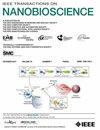Recycling Eggshell Waste Into Calcium Oxide Nanoparticles: A Sustainable Approach for Nanomaterial Synthesis and Potential Applications
IF 4.4
4区 生物学
Q1 BIOCHEMICAL RESEARCH METHODS
引用次数: 0
Abstract
Eggshell (ES) wastes have been ranked as the将蛋壳废料回收成氧化钙纳米颗粒:一种可持续的纳米材料合成方法及其潜在应用。
蛋壳(ES)废物已被列为食品工业的第 15 大污染,原因是人们经常食用的主要膳食产品--鸡蛋的消费量不断增加。全球范围内每天产生的数吨废弃蛋壳的管理和处理已成为一个难题,必须立即提倡解决这一污染问题。这为这种生物垃圾在纳米技术、生物医学和环境污染控制等众多领域的可回收性奠定了基调。贝壳中的碳酸钙使其成为一种安全的前体,可通过自上而下的方法--煅烧--生产纳米材料氧化钙。本文重点介绍了一种从废弃蛋壳中提取金属氧化物纳米粒子的简便方法,该方法具有可重复性和可回收性。在两种不同的煅烧温度下获得的氧化钙纳米颗粒(CaO NPs)进行了优化,并通过扫描电镜、傅立叶变换红外光谱、X射线衍射、DLS和Zeta电位分析仪对其进行了表征。CaONPs 是一种研究较少的金属氧化物纳米粒子,但在不同领域的应用前景广阔。因此,我们有必要进一步研究轻松获得的无毒、无害的 CaO NPs,从而最大限度地减少和规范食品废物。
本文章由计算机程序翻译,如有差异,请以英文原文为准。
求助全文
约1分钟内获得全文
求助全文
来源期刊

IEEE Transactions on NanoBioscience
工程技术-纳米科技
CiteScore
7.00
自引率
5.10%
发文量
197
审稿时长
>12 weeks
期刊介绍:
The IEEE Transactions on NanoBioscience reports on original, innovative and interdisciplinary work on all aspects of molecular systems, cellular systems, and tissues (including molecular electronics). Topics covered in the journal focus on a broad spectrum of aspects, both on foundations and on applications. Specifically, methods and techniques, experimental aspects, design and implementation, instrumentation and laboratory equipment, clinical aspects, hardware and software data acquisition and analysis and computer based modelling are covered (based on traditional or high performance computing - parallel computers or computer networks).
 求助内容:
求助内容: 应助结果提醒方式:
应助结果提醒方式:


